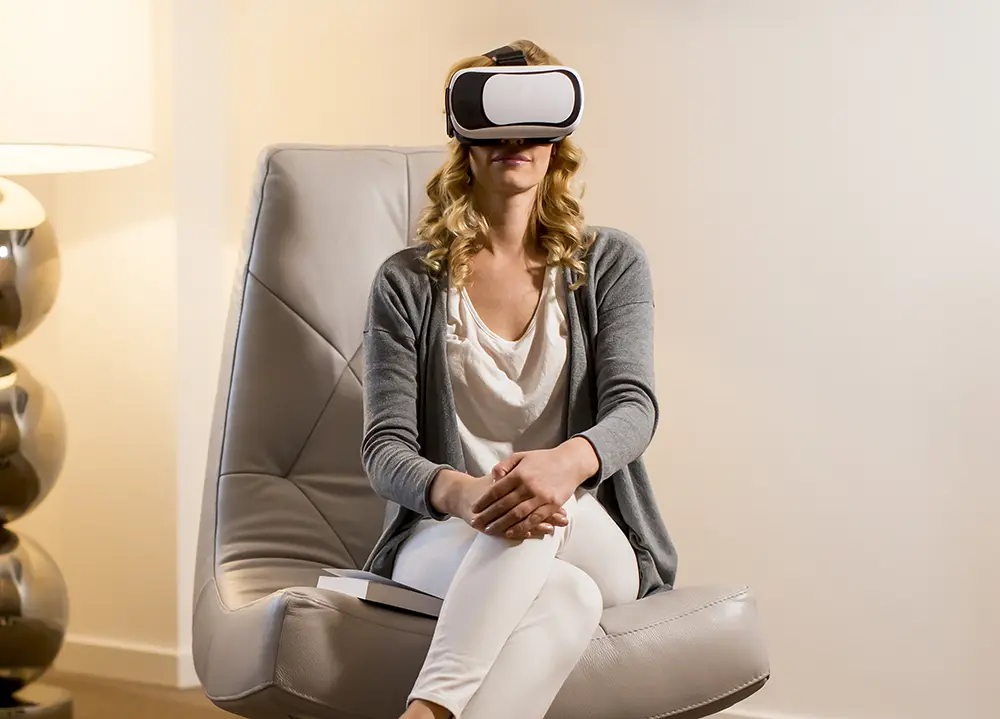EMDR-VR and Virtual Reality Therapy
The combination of the principles of EMDR therapy, which uses bilateral stimulation to alleviate distressing memories, with virtual reality technology to create immersive environments that enhance the therapeutic process. Virtual Reality Therapy leverages virtual reality to simulate real-world environments and scenarios, providing an interactive and controlled space for therapeutic interventions aimed at treating various mental health conditions, such as anxiety, PTSD, and phobias.

The experience of trauma and other mental health issues can leave deep emotional wounds that impact our lives in a profound way. Thankfully, advancements in technology have opened up new avenues for unique and effective therapeutic interventions in healing. EMDR Transformations is proud to offer Eye Movement Desensitization and Reprocessing enhanced with Virtual Reality Therapy (EMDR-VR). This innovative approach combines the proven effectiveness of EMDR with the immersive capabilities of VR technology, offering a dynamic and personalized healing experience.
Virtual reality refers to a virtual world created through technology. When you use VR equipment, such as a VR headset, you can enter virtual environments that appear real and experience an environment as though you are actually in it.
This approach offers a several benefits:
- Virtual reality creates safe and controlled simulated environments in which our clients can explore and process distressing memories and feared experiences. For example, one with a fear of flying (aerophobia) can begin by processing any past negative experiences with traditional EMDR therapyand move on to confront present and anticipated fears like navigating the airport, take off, touch down, handling turbulence, etc., in virtual reality. We apply EMDR therapy within the virtual reality environment desensitizing the fear without ever leaving the office. We have the ability to manipulate the environment to slowly increase the intensity of the experience, allowing clients to master their anxieties in a gradual way. Research has shown this is as effective as in vivo (real life) exposure therapy and is more tolerable.
- In traditional therapy, it may be difficult to evoke the intensity of emotions necessary for effective EMDR reprocessing. VRT can elicit authentic emotional reactions accelerating the desensitization process.
- In traditional EMDR therapy, the client has to be able to imagine and vividly recall past experiences or confronting their most feared situations. Some, such as those with aphantasia, struggle to imagine the scenes that are causing distress VR solves this problem by allowing clients to see and experience a scene directly in front of them.
- VR environments provide a controlled and predictable setting for therapeutic interventions. Distractions and environmental triggers can be eliminated minimizing the risk of retraumatization.
- Clients can explore challenging experiences at their own pace, with the reassurance of a supportive therapist guiding them through the process.
- The use of VRT enhances the effectiveness of EMDR interventions, leading to more efficient and lasting therapeutic outcomes.
- Virtual Reality Therapy transcends geographical and logistical barriers, making mental health treatment more accessible to individuals who may face challenges accessing traditional therapy. By offering virtual sessions, EMDR therapists can reach clients in remote locations or those with mobility limitations, ensuring equitable access to quality care. This inclusivity expands the reach of EMDR therapy and empowers more individuals to embark on the path to healing. (This does require access to a virtual reality headset).
APPLICATIONS:
EMDR-VR therapy may be used to address a wide range of mental health issues. Some examples include:
- Combat-related Trauma
- Phobias and Anxiety Disorders:
- Motor Vehicle Accidents:
- Childhood Trauma
- Alcohol and substance dependence
- Simulate drug-related cues
- Reduce cravings
- Offer controlled exposure to triggers
- Clients develop coping skills
- Improve adherence to treatment
- Eating Disorders and body image issues
- Pain management
By itself, VRT may also be used for mindfulness and relaxation training, emotional regulation, life and social skills development, practicing difficult conversations, meditation, art therapy and play therapy making it appealing to older children, teens and adults.
FREQUENTLY ASKED QUESTIONS:
The most frequently asked questions from patients about using VR in therapy:
“I thought VR was for gaming, how does it work in therapy?”
Yes, VR is often used for gaming; however, the VR environments used in therapy are not experienced like a video game. We have specific applications we use to provide exposure environments that allow clients to work towards specific goals.
“Does virtual reality have any side effects?”
VR can be used with patients of most any age; however, VR headsets are not typically suitable for children under 10.
The following side effects are rare, acute, and tend to be mild:
- Eye pain, dizziness, visual fatigue, or visual abnormalities.
- Redness of the skin, eczema, swelling, irritation, or discomfort.
- Excessive use may cause imbalance or motor incoordination.
Patients should not use VR if they are experiencing any of the following:
- Tiredness or exhaustion
- Under the influence of substances (e.g., alcohol) or hungover
- Digestive distress
- Suffering from cold, flu, headache, migraine, vertigo, or earache.
- Are pregnant, elderly, or suffering from physical, mental, visual, heart, or neurological conditions that may make them prone to seizures (consult with your doctor)

Get In Touch
Call
Hours
Monday - Saturday: 8am - 8pm
Sunday: Closed

